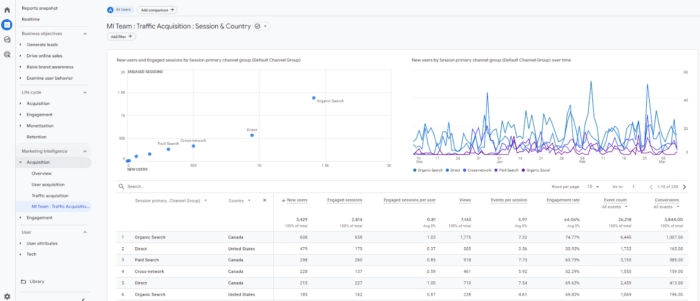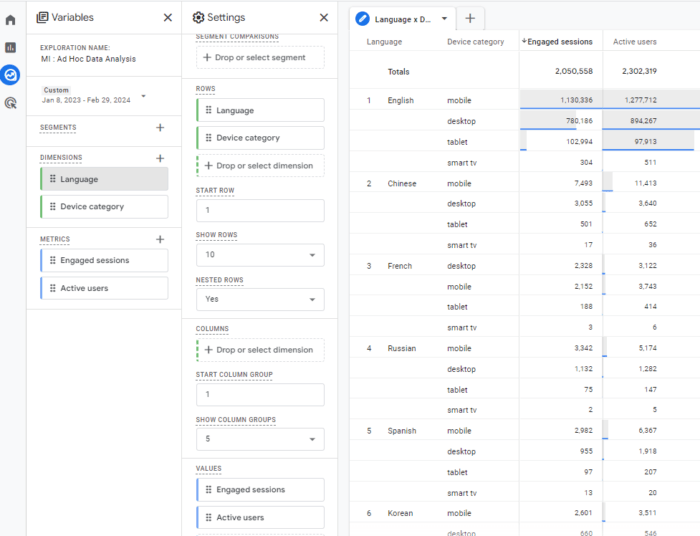Google Analytics 4 – Things (We Think) You Need to Do
Back in December of 2022, I summarized my initial thoughts about the upcoming launch of GA4. It’s now been 8 months since the transition, and in that time Google has continued to make updates to the platform resulting in a steep learning curve for many marketers.
GA4 was never meant to be a ‘set it and forget it’ platform, in order for marketers to make the most of its capabilities and insights we have to tailor the platform to meet the business’ needs.
Appreciating that this can be a daunting task, I have summarized three key things that marketers should be doing in their current GA4 set-ups:
- Audit Your Conversion & Event Set-Up
- Generate Custom Channel Groups
- Build Out Key Reports & Explorations
1. Audit Your Conversion & Event Set Up
Google’s Auto Migration :
In March of 2023, Google began auto-migrating UA set-ups into new GA4 Properties; the only way to avoid this migration was to opt-out before UA shutting down. While this was a good solution to ensure marketers had a GA4 property set-up before the transition, often the conversions that were imported from UA to GA4 did not migrate correctly, and by default were set to a counting method of “once per session” to align with UA’s goal-counting methodology.
Within the Property change history report, you can see all the actions related to the migration. To look at the property’s history, navigate to Admin > Property Settings > Property > Property change history

Automatically Collected & Enhanced Measurement Events :
GA4 automatically collects certain events based on user interactions with the site or app, which includes actions like clicks (outbound), file downloads and form interactions. Avoid burdening the platform with the same action being triggered under two different event names by removing redundant events.
For example, a pdf download is being captured from the GA4 automatically collected event (file_download), and a Google Tag Manager generated trigger (pdf_download).
I am inclined to keep the file_download event as it is more robust compared to the pdf_download, capturing parameters including the file_extentsion, file_name and link_url

2. Generate Custom Channel Groups
A notable feature improvement between UA and GA4 was the addition of new segments into the Default Channel Grouping, including Paid Social, Paid Video and SMS. However, the Default Channel Group works best when marketers are able to align their UTM structure to match the existing rule-based categories laid out by GA4.
Ensuring that all UTM taxonomy matches GA4’s rules is not always feasible; specially since GA4 will evolve the definitions to match market changes. In response to this need, at the end of February 2024, Google rolled out Custom channel groups.
GA4 Standard Properties can have up to two Custom Channel Groups (in addition to the pre-defined channel group), with up to 25 channels in each group. To generate a new channel group, navigate to Admin > Property Settings > Data display > Channel groups.

Consider building Custom channel groups when your business has many ‘Unassigned’ or ‘Paid Other’ traffic in the Default Channel Group reports.
You can also set your new Custom Channel Group as the Primary Channel Group for your property, making it the default reporting channel for reports, as well as being accessible as dimensions on explorations and audiences.
3. Build Out Key Reports & Explorations
Considering Google has devoted a whole page to the data differences between reports and explorations, speaks to just how confusing navigating between these sections can be.
Having pre-set reports and explorations, customized to your team’s needs can reduce the hassle of configuring a data-set every time you need it, and ensuring the teams are using the same dimensions and metrics when speaking to the data.
When considering which to use, remember that the GA4 Property’s data retention setting will impact the date range available in Explorations, where standard aggregated Reports (including primary and secondary dimensions) are not affected.
Utilize Reports when accessing high-level insights that are routinely requested from the business. Editors can customize which dimensions, metrics, and charts appear in the report.
Additionally, GA4’s Library allows marketers to organize reports into collections, and add them into the left navigation menu, allowing different team members to easily access data.

Build Explorations when deeper & more complex analyses are required. While Explorations are great for quick, ad-hoc data investigations, having some pre-prepared can be valuable for marketers when regular data drill-downs are needed.
Along with generating pre-defined reports like Path exploration and Funnel exploration, marketers can use the Free-form exploration to investigate the business metrics that are most valuable to them, that include Campaign Performance, Custom Segmentation, and analyses across more than two dimensions.
For example, the business wants to see if there is justification to release marketing-materials in other languages. A Free-form exploration comparing Engaged sessions and Active users across Language and Device category can assist in answering this question. Not only is the Exploration looking at the user’s preferred language, but we can also identify potential marketing message placements depending on how many users are driven by desktop versus mobile.

Final Thoughts
At first glance, GA4 can feel cumbersome compared to its predecessor, however, taking the time to learn and customize the platform can yield valuable insights that marketers can apply to their business.
Start with these three tips that I have summarized today, and see your sentiments to GA4 soften.
Happy exploring!